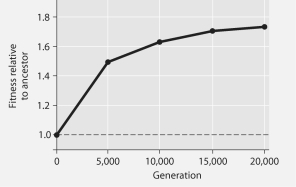Multiple Choice
The following questions refer to Figure 27.1 below, which is the same as Figure 27.10 in the textbook.
In this 8-year experiment, 12 populations of E. coli, each begun from a single cell, were grown in low-glucose conditions for 20,000 generations. Each culture was introduced to fresh growth medium every 24 hours. Occasionally, samples were removed from the populations, and their fitness in low-glucose conditions was tested against that of members sampled from the ancestral (common ancestor) E. coli population.

Figure 27.1
-If the experimental population of E. coli lacks an F factor or F plasmid, and if bacteriophage are excluded from the bacterial cultures, then which of these is a means by which beneficial mutations might be transmitted horizontally to other E. coli cells?
A) via sex pili
B) via transduction
C) via conjugation
D) via transformation
E) both A and C above
Correct Answer:

Verified
Correct Answer:
Verified
Q6: Match the numbered terms to the descriptions
Q7: Foods can be preserved in many ways
Q10: The following questions refer to structures found
Q12: Prokaryotic ribosomes differ from those present in
Q13: Mycoplasmas are bacteria that lack cell walls.
Q14: Regarding prokaryotic reproduction, which statement is correct?<br>A)Prokaryotes
Q15: The data were collected from the heterocytes
Q24: Though plants, fungi, and prokaryotes all have
Q27: Which of the following obtain energy by
Q34: If all prokaryotes on Earth suddenly vanished,